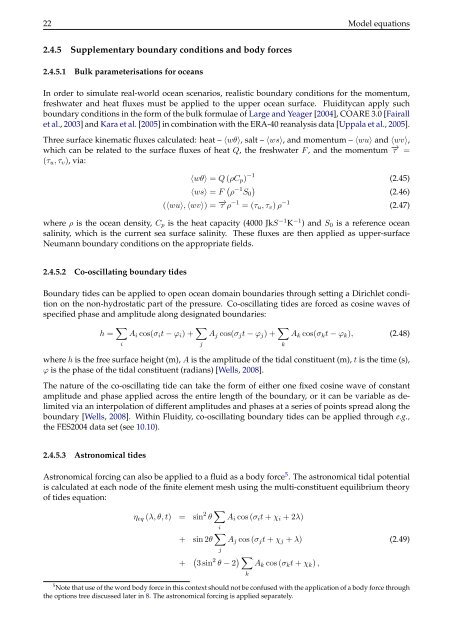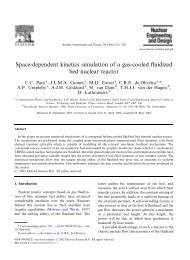Chapter 8 Configuring Fluidity - The Applied Modelling and ...
Chapter 8 Configuring Fluidity - The Applied Modelling and ...
Chapter 8 Configuring Fluidity - The Applied Modelling and ...
You also want an ePaper? Increase the reach of your titles
YUMPU automatically turns print PDFs into web optimized ePapers that Google loves.
22 Model equations<br />
2.4.5 Supplementary boundary conditions <strong>and</strong> body forces<br />
2.4.5.1 Bulk parameterisations for oceans<br />
In order to simulate real-world ocean scenarios, realistic boundary conditions for the momentum,<br />
freshwater <strong>and</strong> heat fluxes must be applied to the upper ocean surface. <strong>Fluidity</strong>can apply such<br />
boundary conditions in the form of the bulk formulae of Large <strong>and</strong> Yeager [2004], COARE 3.0 [Fairall<br />
et al., 2003] <strong>and</strong> Kara et al. [2005] in combination with the ERA-40 reanalysis data [Uppala et al., 2005].<br />
Three surface kinematic fluxes calculated: heat – 〈wθ〉, salt – 〈ws〉, <strong>and</strong> momentum – 〈wu〉 <strong>and</strong> 〈wv〉,<br />
which can be related to the surface fluxes of heat Q, the freshwater F , <strong>and</strong> the momentum −→ τ =<br />
(τu, τv), via:<br />
〈wθ〉 = Q (ρCp) −1<br />
〈ws〉 = F � ρ −1 �<br />
S0<br />
(〈wu〉, 〈wv〉) = −→ τ ρ −1 = (τu, τv) ρ −1<br />
(2.45)<br />
(2.46)<br />
(2.47)<br />
where ρ is the ocean density, Cp is the heat capacity (4000 JkS −1 K −1 ) <strong>and</strong> S0 is a reference ocean<br />
salinity, which is the current sea surface salinity. <strong>The</strong>se fluxes are then applied as upper-surface<br />
Neumann boundary conditions on the appropriate fields.<br />
2.4.5.2 Co-oscillating boundary tides<br />
Boundary tides can be applied to open ocean domain boundaries through setting a Dirichlet condition<br />
on the non-hydrostatic part of the pressure. Co-oscillating tides are forced as cosine waves of<br />
specified phase <strong>and</strong> amplitude along designated boundaries:<br />
h = �<br />
Ai cos(σit − ϕi) + �<br />
Aj cos(σjt − ϕj) + �<br />
Ak cos(σkt − ϕk), (2.48)<br />
i<br />
j<br />
where h is the free surface height (m), A is the amplitude of the tidal constituent (m), t is the time (s),<br />
ϕ is the phase of the tidal constituent (radians) [Wells, 2008].<br />
<strong>The</strong> nature of the co-oscillating tide can take the form of either one fixed cosine wave of constant<br />
amplitude <strong>and</strong> phase applied across the entire length of the boundary, or it can be variable as delimited<br />
via an interpolation of different amplitudes <strong>and</strong> phases at a series of points spread along the<br />
boundary [Wells, 2008]. Within <strong>Fluidity</strong>, co-oscillating boundary tides can be applied through e.g.,<br />
the FES2004 data set (see 10.10).<br />
2.4.5.3 Astronomical tides<br />
Astronomical forcing can also be applied to a fluid as a body force 5 . <strong>The</strong> astronomical tidal potential<br />
is calculated at each node of the finite element mesh using the multi-constituent equilibrium theory<br />
of tides equation:<br />
ηeq (λ, θ, t) = sin 2 θ �<br />
i<br />
Ai cos (σit + χi + 2λ)<br />
k<br />
+ sin 2θ �<br />
Aj cos (σjt + χj + λ) (2.49)<br />
j<br />
+ � 3 sin 2 θ − 2 � �<br />
Ak cos (σkt + χk) ,<br />
5 Note that use of the word body force in this context should not be confused with the application of a body force through<br />
the options tree discussed later in 8. <strong>The</strong> astronomical forcing is applied separately.<br />
k




